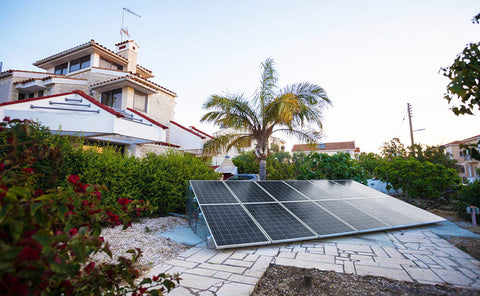
Do you have noticed the color of solar panels

Is it common that your neighbors installed residential solar systems? And have you look around and find their solar panels are different, especially in colors. As we `ve got our traditional black and blue options, but other choices? Not so much. Now, if you love a rainbow of flavors, this may pain you. Or, if you have a specific color scheme in mind for your home or yard, these bland options may muck it all up. And let`s take a tour of the wonderful world of solar panels.
How are black and blue solar panels different?
To start, most solar panels are made of silicon, a naturally occurring, nonmetallic element found in our favorite planet’s crust (Earth, of course). Silicon is used because of its conductivity – i.e., its ability to produce an electric charge and the wide range of light wavelengths it can absorb. The silicon used in solar panels is in a crystalline form. The blue or black color depends on the process used to produce the panels. Blue solar panels are polycrystalline.
This means that the silicon used to make them comes from multiple sources.Producing poly solar panels involves melting the silicon together and pouring the resulting mixture into a square mold. As the mixture hardens, individual crystals form. The result is a faceted, non-uniform appearance that has almost a shimmering look. On the other hand, monocrystalline solar panels come from a single source.They appear black in color because of the way that the light interacts with them. Because the silicon comes from a single source, they are more uniform in appearance.
What are the pros and cons of Mono VS Poly solar panels
The main advantage of black mono solar panels is their impressive efficiency. Even under sub-par conditions, such as low light and high heat, they perform better and produce closer to their rated output. Their weakness? Wasted material. During the manufacturing process, corners are trimmed off the squares cut from silicon wafers. Because the silicon for blue polycrystalline solar panels comes from multiple sources, the manufacturing process is less wasteful. Polycrystalline solar panels are cheaper to produce than monocrystalline solar panels, and therefore, less expensive to purchase. However, polycrystalline solar panels are less efficient.
Are different colored solar panels available?
Solar panels are (currently) only available in black and blue for those of us aesthetically concerned. It then becomes a little more challenging to match our existing roof or blend into our yard. But there is hope. There have been attempts to change the appearance of solar panels with color coatings. Yet, this results in an efficiency loss. And there have been experiments to change solar panels by laying networks of small silicone cylinders over the top of the panels. When sunlight hits the panels, some of the light scatters. The cylinders change the wavelength of the scattered light so that our eyes perceive it as a particular color. Although promising, this technology is far from roll-out.
Colors may be limited but performance is key
Ultimately, the crayon box of solar panels is still a ways off. But there are many factors other than color to consider when choosing between monocrystalline vs. polycrystalline panels.You want the best performance to match your needs and your budget. If you’d like more guidance in choosing the best solar panels for you, contact us. We’d love to talk with you!
Facebook: Xinpuguang Solar Panel
Instagram: xinpuguangsolar
Pinterest: XinpuguangSolarPanels
Homepage: https://xinpuguangsolar.com
Email address: Philip@isolarparts.com
- A escolha de uma seleção resulta em uma atualização completa da página.
